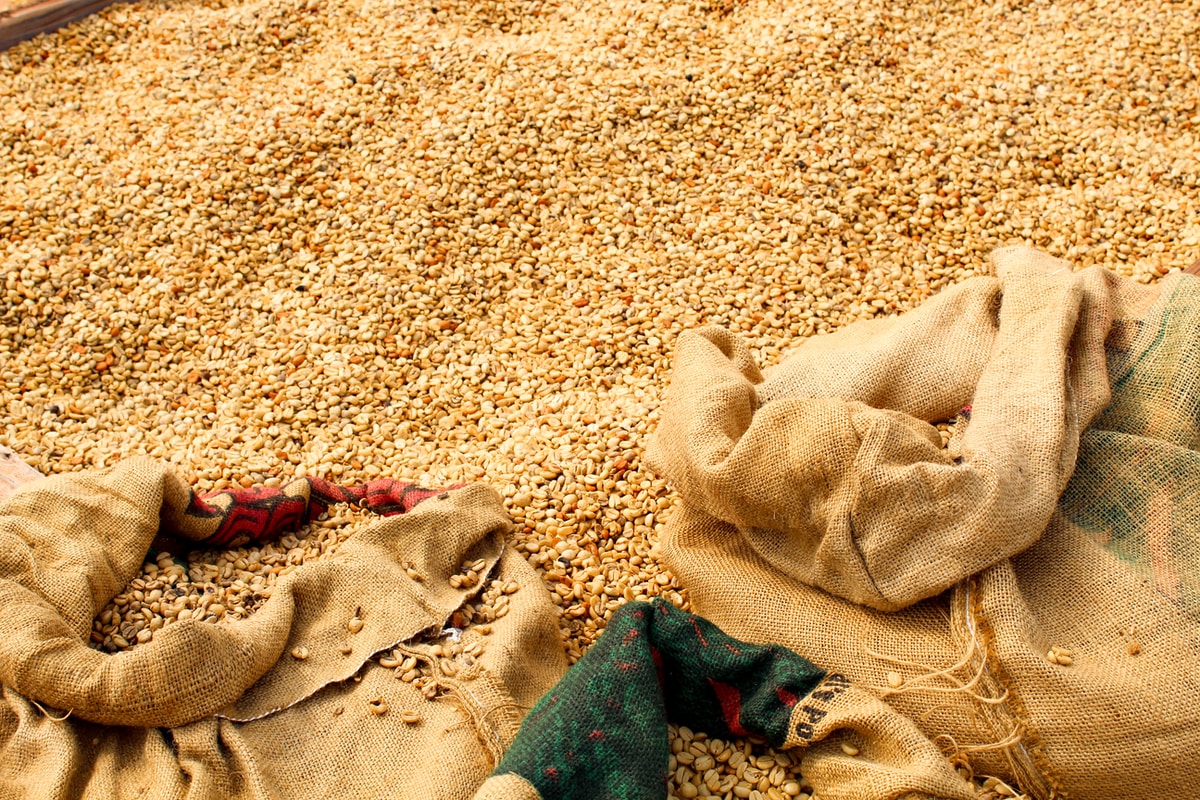Ethiopian Coffee Culture Coffee Flavor characteristics of different producing areas in Ethiopia

Ethiopia is recognized as the birthplace of coffee, and the coffee produced is also highly respected in the boutique coffee market, and Ethiopian coffee is almost available on the menu of coffee shops around the world.
But why is Ethiopian coffee so well received? How well do you know this coffee-producing country?
Ethiopia's producing areas vary greatly, and the cup flavor profiles of coffee produced by each producing area, micro-producing area and even farm are also very different, but no matter which producing area, as long as it is Arabica coffee in Ethiopia, many people can't stop. In this article, let's take a look at the origin of this coffee.
Coffee is the core of Ethiopian culture
In Ethiopia, coffee production is both the labor of most people and an important source of income, and coffee is also integrated into the culture and economy of the country.
Ethiopia is the sixth largest coffee producer in the world. It is reported that 100 million people are directly or indirectly engaged in the coffee industry worldwide in 2018, and Ethiopian coffee workers account for 20% of the 100 million people. In 2017, the country produced about 470000 tons of raw coffee beans, of which about 160000 tons were exported, which means that Ethiopia exports less than half of its total coffee production and consumes the rest domestically.
Coffee has been integrated into the social fabric of Ethiopia for hundreds of years. It is reported that the common word used in local social activities is "buna tetu", which means "drink coffee". One of the most famous Ethiopian proverbs is "buna dabo naw", which means "coffee is our bread".
Coffee-related rituals are a long tradition and cannot be done in haste. Stir-fry the raw beans in a pan over charcoal fire, mash them with a pestle and bowl, and then brew them in a traditional container with a narrow mouth. Coffee is served in small cups without handles, which means there is no choice but to sip slowly and patiently.
Ethiopians have a unique relationship with coffee. In France, if someone brings you coffee at home, they will probably cook it directly in a capsule coffee machine, which can be done in 17 seconds. In Ethiopia, if you want to drink coffee, you have to wait 45 minutes for the ceremony.

The method of coffee production in Ethiopia
Ethiopian coffee is usually grown in an environmentally sustainable way, mostly in the form of "courtyard coffee", which is planted directly next to farmers' houses and along with other crops. Local "semi-forest coffee" is also common, which adjusts shade trees by pruning weeds and bushes in natural forests, and then introducing coffee seedlings after the above actions have been completed. It is estimated that only 5% of Ethiopia's coffee production comes from farms that specialize in growing coffee.
The types of farmers who grow coffee in Ethiopia include sub-contract farmers, plantations and smallholder farmers, while Ethiopian smallholder groups are organized in accordance with the principles of cooperatives and are voluntary and open to all farmers.
Any small farmer who is willing to join a cooperative and is able to assume responsibility for each other can join on the basis of non-discrimination against gender, social status, race, disability, religion, etc. Cooperatives are democratic organizations co-operated by their members who actively participate in and work together to make policies and decisions; each member has an equal right to vote.
Coffee cooperatives support and encourage small farmers to use good agricultural practices, such as harvesting ripe coffee fruits, using sun or water washing to treat coffee, and if they have the ability to export, the exported coffee can distribute dividends to members of the cooperative.
Two or more primary cooperatives can form trade unions, which support the harvest and processing of each primary cooperative in the Ethiopian coffee supply chain and carry out secondary processing, including shelling, grading, packaging and export of coffee, at the same time distributed to their respective cooperatives.
This is an effective grading system that focuses on complete and consistent monitoring while complying with strict international quality standards, which is very important for boutique coffee buyers.
Ethiopian coffee treatment method
Both washed and tanned coffee are common in Ethiopia. In sun treatment, farmers put the coffee fruit on a flat surface and then dry it in the sun. This process usually takes two to six weeks, then tilt and rotate the fruit to dry evenly. When the seed is dry, take it out of the fruit.
Ethiopian washed coffee exudes elegance, with floral and citrus and fine tasting notes, and has a smooth taste. However, flavor characteristics vary greatly from region to region.
Sun-tanned coffee usually has a strong, round fruit flavor, and deeper, compared with the same kind of washed coffee, high-quality sun-cured coffee has a clean citrus aroma and floral freshness, and adds sweetness and mellow thickness. When you can find one of these characteristics, the other flavor characteristics will not be too bad. Now there is more and more honey-treated coffee in Ethiopia. I think this is because farmers can sell directly to the market, and the sales are good.
Ethiopian producing area and its corresponding flavor characteristics
Because Ethiopia has obvious changes in topography and altitude, and there are various varieties and unclassified native species, the flavor of coffee varies greatly, which leads to the purchase benchmark of coffee buyers. Will tend to produce areas, altitude and cup test scores to look forward to ten thousand, rather than the use of varieties to distinguish Ethiopian coffee.
In Ethiopia, there are the following main producing areas, as well as their corresponding flavor characteristics:
Sidamo
Sidamo is a large area of land on the fertile plateau of the Rift Valley and is one of three branded coffee-producing areas in Ethiopia (the other two are Hara and Yegashefi). The elevation of Sidamo ranges from 1550 to 2200 meters, with abundant rainfall, suitable temperature and fertile soil.
According to relevant records, about 60% of the coffee produced in this area is washed. Sidamo Coffee is famous for its rich, full and vibrant bright acidity, as well as floral and citrus aromas.
Yejia Xuefei
Yega Xuefei is part of the Sidamo producing area, but because of its excellent quality, it is independently subdivided into its own micro-producing areas. Although some sun-cured coffee is produced here, most of the coffee produced here is washed.
The Yega Sheffield Coffee Farmers' Cooperative Union (YCFCU) has 28 major cooperative members, representing farmers with more than 45000 members in the region. Andualem Shiferaw, Deputy General Manager of YCFCU, said: "the general YCFCU is characterized by bright acidity, medium mellow thickness coffee, unique aroma, rich floral aroma, medium and high strength acid, full and long finish. "
Flavor characteristics may vary depending on altitude; for example, coffee produced by the Chichu and Michle Cooperative at an altitude of 1600 to 1800m has a vanilla aroma. However, coffee from the Idido, Adadao and Aramo cooperatives may give off the scent of flowers at an altitude of 2, 000 to 2, 400 meters.
Hara.
This is a wild Arabica coffee that grows on a small farm in Oromia, the predecessor of Hara, at 1400 to 2000 meters above sea level. It is usually treated in the sun.
Hara is known for its strong fruit aroma and acidity, which is often described as full-bodied and spicy with strong blueberry or BlackBerry flavors. Usually it has a high alcohol thickness and is compared to red wine. Its strength feature means that it is most commonly used in the formula beans of espresso rather than as a single coffee.
Lim.
Lim coffee grows in southwestern Ethiopia, between 1100 and 1900 meters above sea level. Washed coffee with low acidity has a well-balanced mellow thickness and unique spicy taste, pleasant sweetness and often floral aroma.
Gemma.
This producing area in southwestern Ethiopia produces large quantities of commercial coffee. Planting is located at 1400-2100 meters above sea level. It is reported that the coffee in this area, also known as Djimmah, is best treated with water, because it often gives the coffee a medicinal flavor if used in the sun.
Challenges of Coffee production in Ethiopia
Climate change poses a serious threat to coffee production in Ethiopia, in particular the increasing incidence and duration of drought. The new weather conditions are seriously damaging agriculture, which accounts for 85% of the country's population.
A report published in the magazine Nature in 2017 said: "without major measures to deal with the effects of climate change, 3959% of coffee growing areas may no longer be suitable for growing coffee. "
The industry also faces the following challenges: low rate of farmers entering the fair trade market, improper handling of good coffee, insufficient diversity of farmers' sources of income, high production costs, lack of market information, and so on.
Unsustainable consumption is reducing the cost that farmers are willing to spend on sustainable production. We can see that the people who currently determine the market price quote less than $1 per pound for this type of coffee that meets the ethical requirements, which will prevent buyers and importers from making ethical purchases. In fact, this requires the active efforts of the fair trade system and civil society to raise consumer awareness of sustainable and ethical consumption.
Coffee market movements and other policy issues are affecting the business of Ethiopian cooperatives, and YCFCU is looking for a way to overcome these problems, including the installation of bean roasters and grinders to allow producers to roast and grind their own coffee. The main purpose of these new projects is to provide cooked beans and coffee powder products to corners that are difficult for us to reach.
Traceability and transparency
Cooperative unions and owners of coffee farms can export their coffee directly to international buyers, but private exporters usually buy coffee through the Ethiopian Commodity Exchange (ECX) and then export their coffee to international buyers. The basic function of ECX is to provide a centralized, standardized organization in which agricultural products and futures can be bought and sold.
All coffee entering the ECX will be given a grade and geographical indication, but this means that the coffee will only be marked to the producing area or mini-producing area, and it is difficult to trace the product to a specific place of origin through the system. This is not ideal for the boutique coffee market that attaches importance to traceability.
The boutique coffee market emphasizes coffee whose output and quality are stable and traceable. The market needs to be consistent for years to test the flavor of the unique cup. If this coffee is not traceable, we cannot say that it is a special coffee and cannot be sold in the boutique coffee market.
If you want to buy traceable high-quality coffee from Ethiopia and minimize the number of roles in the supply chain, you can buy it directly from farmers, at least to meet the cost of sustainable production. Cut off unscrupulous traders to reduce end costs, while buying directly from farmers ensures traceability and sustainable quality. Bean bakers need to work with coffee farmers to combat unsustainable consumption and contribute to the sustainable production of coffee.
Ethiopia is a major coffee producer, consumer and exporter at the same time. The quality and diversity of coffee is undeniable, if you want to buy some high-quality coffee, Ethiopia will not let you down.
Ethiopian coffee performs well in all aspects in terms of coffee flavor, production history, future potential and even potential risks.
By buying directly from producers or cooperatives, you have a better chance of obtaining coffee with a unique and delicious flavor that can be traced back to the country of origin.
Ethiopian Yejasuefi red cherry
■ country Ethiopia
■ producing area Yega Xuefei
■ 1700-2200m above sea level
■ flavors of berries, lemons and fermented fruits
Washing and insolation by ■ treatment
Important Notice :
前街咖啡 FrontStreet Coffee has moved to new addredd:
FrontStreet Coffee Address: 315,Donghua East Road,GuangZhou
Tel:020 38364473
- Prev

The effect of temperature on Coffee how to feel the Coffee Flavor during High temperature and cooling
Have you ever had the experience of getting a cup of hot coffee, only to find that the flavor and aroma are different when it is cooled? When this happens, you may start to drink delicate flavors and aromas that you couldn't taste before. You may find that your coffee now has a distinct sweet, fruity or floral flavor. This change in flavor is due to specific chemical reactions triggered by temperature fluctuations.
- Next

Flavor characteristics of Indian monsoon Malaba coffee monsoon treatment of coffee beans
Background of Malaba in India in the 17th century a Muslim named BABA BUDAM made a pilgrimage to Mecca and brought coffee tree seeds back to India. He planted the seeds near his hut in mysore. In 1840, the British began to plan to grow coffee in South India. Karnataka, located in the southwest of malabar, India, is a major producer.
Related
- Beginners will see the "Coffee pull flower" guide!
- What is the difference between ice blog purified milk and ordinary milk coffee?
- Why is the Philippines the largest producer of crops in Liberia?
- For coffee extraction, should the fine powder be retained?
- How does extracted espresso fill pressed powder? How much strength does it take to press the powder?
- How to make jasmine cold extract coffee? Is the jasmine + latte good?
- Will this little toy really make the coffee taste better? How does Lily Drip affect coffee extraction?
- Will the action of slapping the filter cup also affect coffee extraction?
- What's the difference between powder-to-water ratio and powder-to-liquid ratio?
- What is the Ethiopian local species? What does it have to do with Heirloom native species?

